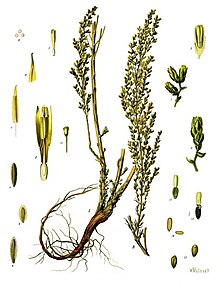Santonin
| Structural formula | ||||||||||||||||
|---|---|---|---|---|---|---|---|---|---|---|---|---|---|---|---|---|

|
||||||||||||||||
| General | ||||||||||||||||
| Surname | Santonin | |||||||||||||||
| other names |
|
|||||||||||||||
| Molecular formula | C 15 H 18 O 3 | |||||||||||||||
| Brief description |
colorless crystals that turn yellow in the light; bitter taste |
|||||||||||||||
| External identifiers / databases | ||||||||||||||||
|
||||||||||||||||
| properties | ||||||||||||||||
| Molar mass | 246.31 g · mol -1 | |||||||||||||||
| Physical state |
firmly |
|||||||||||||||
| density |
1.19 g cm −3 |
|||||||||||||||
| Melting point |
174 ° C |
|||||||||||||||
| boiling point |
(sublimed at 120 ° C ) |
|||||||||||||||
| solubility |
slightly soluble in hot water, readily soluble in hot ethanol and hot diethyl ether |
|||||||||||||||
| safety instructions | ||||||||||||||||
|
||||||||||||||||
| Toxicological data | ||||||||||||||||
| As far as possible and customary, SI units are used. Unless otherwise noted, the data given apply to standard conditions . | ||||||||||||||||
Santonin (santoninic anhydride) is the active component of the so-called worm seed , from which it is manufactured in the factory. Santonin forms shiny, white, tabular crystals that are odorless and tasteless, but taste strongly bitter in alcoholic solution.
history
The substance was discovered in 1830 by Kahler in Düsseldorf and Joachim August Alms (1803–1847) in Penzlin . In the USA, santonin was the first commercially successful medicinal substance from Pfizer .
Extraction and presentation
Santonin is contained in worm seeds ( Artemisia cina , lemon blossom) and can be obtained by extraction with dilute milk of lime and precipitation with dilute hydrochloric acid . Resin also deposited is removed from hot ammoniacal water.
properties
The melting point is 174 ° C. In water the Santonin is sparingly soluble, opposite litmus it has no effect. From a chemical point of view, it is the lactone of the monoprotonic santoninic acid (C 15 H 20 O 4 ) and has the formula C 15 H 18 O 3 .
By boiling santoninsaurem barium with barium hydroxide is a new, but isomeric acid Santo acid . In scattered daylight, faster in direct sunlight, the santonin turns yellow and must therefore be stored in black glasses in the dark. Its acid, santonic acid, on the other hand, does not change color in sunlight.
Hermann Trommsdorff's observation that crystals of Santonin burst in sunlight in 1834 was an early result of photochemistry .
use
Like santonin acid sodium, santonin was previously used against roundworms , but is no longer used because of its toxicity. Even 2-3 times the daily dose (100 mg for adults) can cause symptoms of poisoning, which are initially expressed in purple then yellow vision; cramps and diarrhea can also occur. However, damage to the optic nerve has also been observed after prolonged use of therapeutic doses.
Individual evidence
- ↑ a b Entry on Santonin. In: Römpp Online . Georg Thieme Verlag, accessed on June 13, 2014.
- ↑ a b c d e Handbook of Chemistry & Physics, 59th edition.
- ↑ a b c data sheet (-) - α-Santonin from Sigma-Aldrich , accessed on April 22, 2011 ( PDF ).
- ^ Harry Auterhoff , Textbook of Pharmaceutical Chemistry, Wissenschaftliche Verlagsgesellschaft Stuttgart, 1968.
- ↑ Habermehl / Hammann / Krebs / Ternes, Naturstoffchemie, 3rd edition, Springer Verlag 2008, ISBN 978-3-540-73732-2 .
literature
- Ludmila Birladeanu: The Story of Santonin and Santonic Acid . In: Angewandte Chemie . tape 115 , no. 11 , March 2003, p. 1236-1242 , doi : 10.1002 / anie.200390289 .

